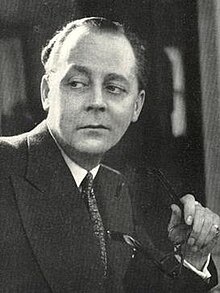Digby Morton
| Digby Morton | |
|---|---|

Digby Morton, 1949
|
|
| Born |
Henry Digby Morton November 27, 1906 Dublin |
| Died | 5 December 1983 London |
| Occupation | Fashion designer |
| Notable credit(s) | Aberfoyle International Fashion award, New York, 1956 |
Henry Digby Morton (1906–1983) was an Irish fashion designer and among the leading names of British couture in the period from 1930-50. He was also among the pioneers of ready-to-wear fashions in the 1950s. Successful on both sides of the Atlantic, he redefined women's suits and tailoring, earned himself the moniker 'Daring Digby' for his US fashion venture and helped to establish the Incorporated Society of London Fashion Designers, an early forerunner of the British Fashion Council.
His contemporary Hardy Amies said of Morton: "[His] philosophy was to transform the suit from the strict tailleur, or the ordinary country tweed suit with its straight up and down lines, uncompromising and fit only for the moors, into an intricately cut and carefully designed garment that was so fashionable that it could be worn with confidence at the Ritz".
Henry Digby Morton was born in Dublin, the son and grandson of accountants for the Guinness brewing organisation. He studied architecture at Dublin Metropolitan School of Art, moving to London in 1923.
Working first at Selfridges and Liberty, he then moved on to the fashion store Jay's as a sketch artist recreating Paris designs to appeal to London customers. By 1928, he'd become designer for couture house Gray Paulette & Shingleton – bringing both his own staff and his design flair. He suggested that it be rebranded as Lachasse – he later said this was because British women wouldn't accept any designs without a French-sounding name. Lachasse specialised in sportswear – a key 1920s trend – and Morton created a debut collection featuring Donegal tweed in what were then radical colour combinations such as bright greens and pale blues blended with traditional browns. This updated hitherto 'stuffy' country tweeds into smart town clothing, especially as Morton also streamlined the cut and tailoring to make the suits more fitted and fashionable. He left Lachasse after five years (he was succeeded by Hardy Amies) in order to set up his own couture house. He married the editor of Woman and Beauty Phyllis Panting (known professionally as Anne Seymour) in 1936.
...
Wikipedia
